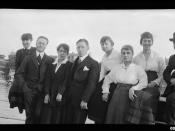Milton wrote extensively throughout his life, and studied literature profoundly. His
cunningness and literary techniques were observed in all of his literature. However, at the
prime of his life, his weak eyes gave as his intense work and studies caused his blindness.
As a result of this tragedy, Milton created a sonnet about his blindness. He questioned the
meaning of this tragedy, of the future, and God for his blindness within the sonnet. Even
though his whole life and work involved his eyes, he accepted this eventually. Within
Milton's sonnet about his blindness: figurative language, personification, his intent and
prosody are adopted to convey his questions and heart felt acceptance of his blindness.
Milton uses figurative language to express his grievances and discontent. He
reflects upon his life and "how my light is spent," or the time he had his sight. Milton then
expresses the feeling of the "dark world and wide" of the blind as his introduction to his
questions. He begins to question his writing that only death can take away ("...one talent
which is death to hide.."), "lodged... useless" within him because of his new blindness. As
a result, Milton begins to question God, "Doth God exact day-labour, light denied?" Milton
wonders as to the meaning of his blindness; Does God want him to continue to write, even
with his blindness, or what does God really mean? At first his tone seems harsh, but his
feelings are redirected as he answers his own questions in time. His last question to God,
was answered by himself as he realizes that he cannot blame God for his actions. His
figurative language from the point he begins to question, up to where he begins to answer
his own questions are full of implications of his thought. These implications...


